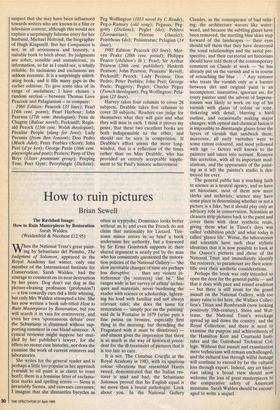How to ruin pictures
Brian Sewell
The Ravished Image: How to Ruin Masterpieces by Restoration Sarah Walden (Weidenfeld & Nicolson £12.95)
When the National Trust's great paint- ing by Sebastiano del Piombo, The Judgment of Solomon, appeared in the Royal Academy last winter, only one member of the International Institute for Conservation, Sarah Walden, had the courage to comment on its near destruction by her peers. Dog don't eat dog in the picture-cleaning profession (profession?) — a few cowardly curs did a little whining, but only Mrs Walden attempted a bite. She has now written a book sub-titled How to Ruin Masterpieces by Restoration, but you will search it in vain for controversy, and even her own 'spontaneous debate' over the Sebastiano is dismissed without sup- porting comment in one bland sentence. A cynical reviewer might suppose her muz- zled by her publisher's lawyer, for she offers no recent case histories, nor does she examine the work of current restorers and laboratories.
She writes for the general reader and is perhaps •a little too popular in her approach (varnish to oil paint is as claret to roast beef); there is a feminine litter of exclama- tion marks and spelling errors — Siena is invariably Sienna, and canvases canvasses; I imagine that she dismantles bycycles as often as tryptychs; Domenico looks better without an h; and even the French do not claim that nationality for Liotard. Tire- some minor errors in so brief a book undermine her authority, but a foreword by Sir Ernst Gombrich supports it; their shared argument is neatly put by the man who has consistently questioned the restora- tion policies of the National Gallery — 'the slow inevitable changes of time are perhaps less disruptive . . than any violent in- terference (by restorers) can be.' She ranges wide in her survey of artists' techni- ques and materials, never burdening the reader with science or scholarship, lighten- ing his load with familiar and not always relevant tales; she does the same for restoration — 'simply pee on the painting' said de la Fontaine in 1679 (urine puts a fine patina on bronzes, especially first thing in the morning, but drenching the Fragonard with it must be disastrous) and almost gives the impression that there is so much in the way of historical prece- dent for the ill-treatment of pictures that it is too late to care.
It is not. The Cimabue Crucifix at the Royal Academy in 1983, with its spurious colour vibrations that resembled Harris tweed, demonstrated that the Italian res- torer is mad and bad; the Sebastiano Solomon proved that his English equal is no more than a brutal pathologist. Look about you. In the National Gallery
Claudes, as the consequence of bad relin- ing, the architecture wavers like water- weed, and because the subtling glazes have been removed, the startling blue skies step forward of the landscapes — their eyes should tell them that they have destroyed the tonal relationships and the aerial pre- spective, and their curatorial art historians should have told them of the contemporary comment on Claude at work — 'he has already put on the varnish and is in course of retouching the blue . . .' Any restorer who treats the varnish only as a barrier between dirt and original paint is an incompetent, insensitive, ignorant ass, for every painter until the advent of Impress- ionism was likely to work on top of his varnish with glazes of colour or tone, tinkering with detail, blurring a hard outline, and occasionally making major changes; with optical and chemical fusion it is impossible to disentangle glazes from the layers of varnish that sandwich them; moreover, all early varnishes were to some extent coloured, and most yellowed with age — factors well known to the painters and taken into account. Remove this accretion, with all its important mod- ulations, and the appearance of the paint- ing as it left the painter's studio is des- troyed for ever.
The general public has a touching faith in science as a neutral agency, and so have art historians, most of them now mere clerks and archivists; science may have some place in determining whether or not a picture is a fake, but it should play only an advisory role in conservation. Scientists as cleaners strip pictures back to the paint and cover them with clear synthetic resin, giving them what in Tissot's days was called 'exhibition pitch' and what today is called 'glance life'. Worse, the laboratories and scientists have such clear stylistic identities that it is now possible to look at the Queen's pictures and ,those of the National Trust and immediately identify the restorers, so paramount are their scien- tific over their aesthetic considerations.
Perhaps the book was only intended to open the door for the general public — and that it does with pace and reined erudition — but there is still room for the grand assault on the National Gallery, with too many ruins to list here, the Wallace Collec- tion's Titian and Rembrandt (now looking positively 19th-century), Steen and Wat- teaus, the National Trust's wreckage spread up and down the country, and the Royal Collection; and there is need to examine the purpose and achievements of the Hamilton Kerr and Courtauld Insti- tutes and the Gateshead Technical Col- lege. Without that assault and examination mere technicians will remain unchallenged, and the cultural loss through wilful damage will continue to exceed by far the cultural loss through export. Indeed, any art histo- rian taking a broad view should now welcome the loss of great masterpieces to the comparative safety of American museums. Sarah Walden should be encour- aged to write a sequel.


















































 Previous page
Previous page